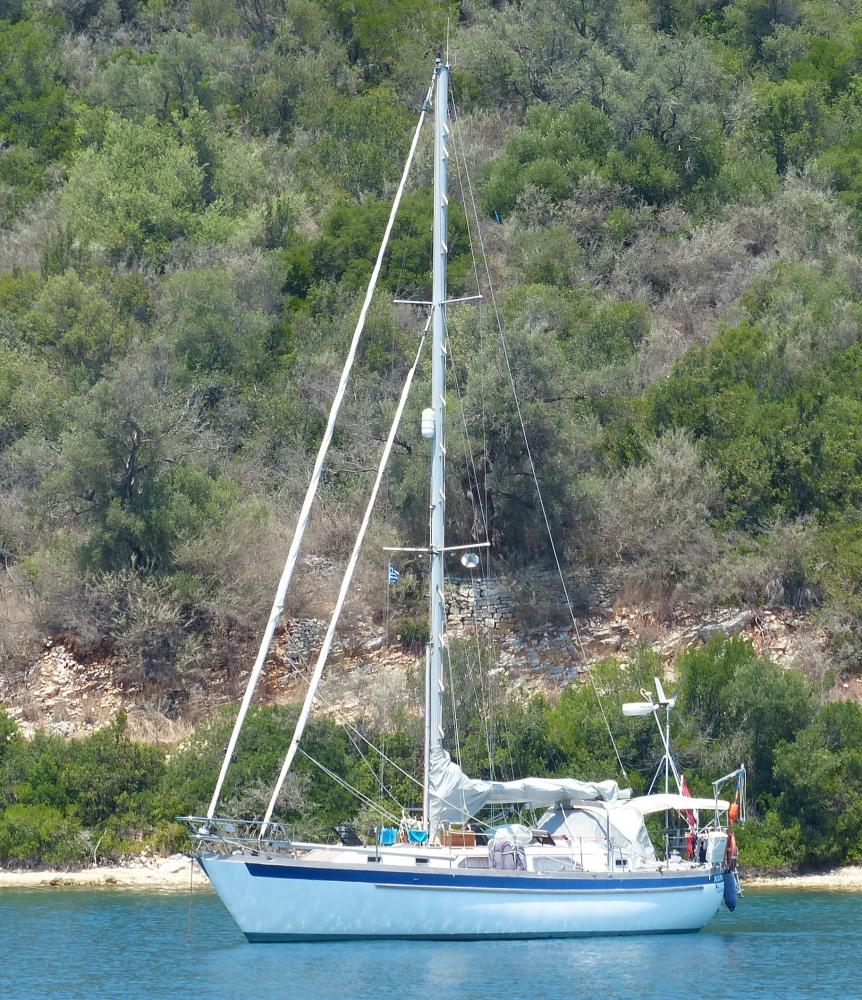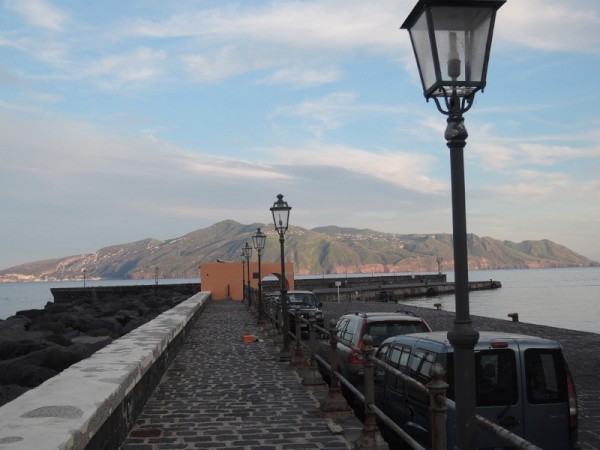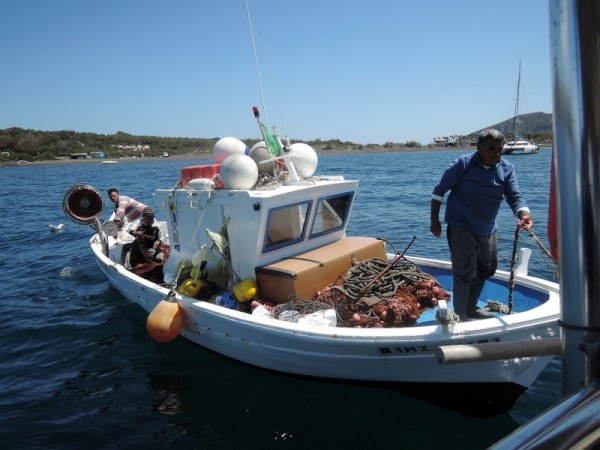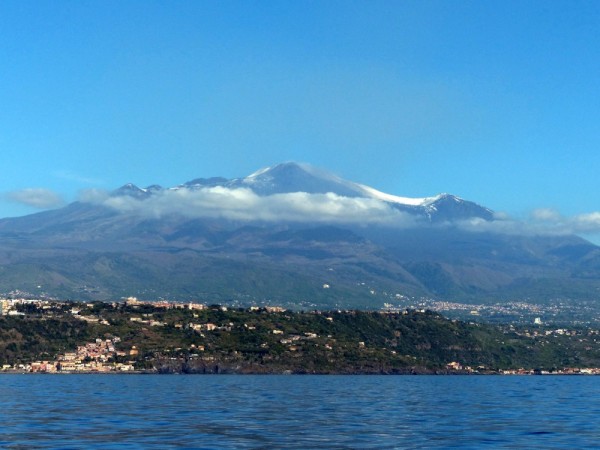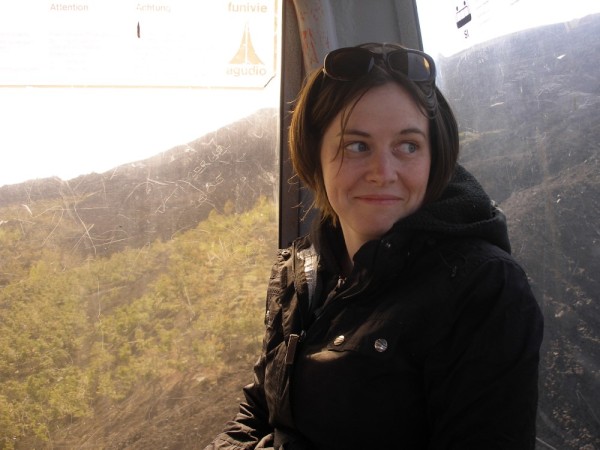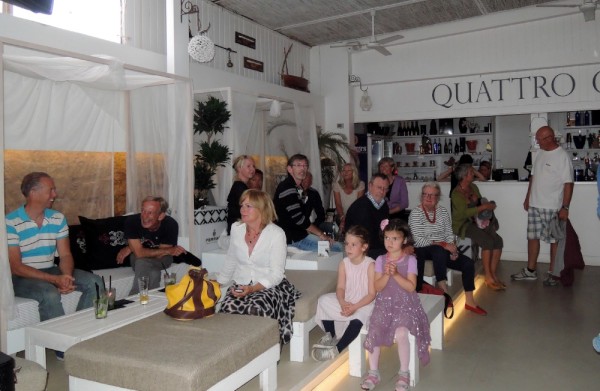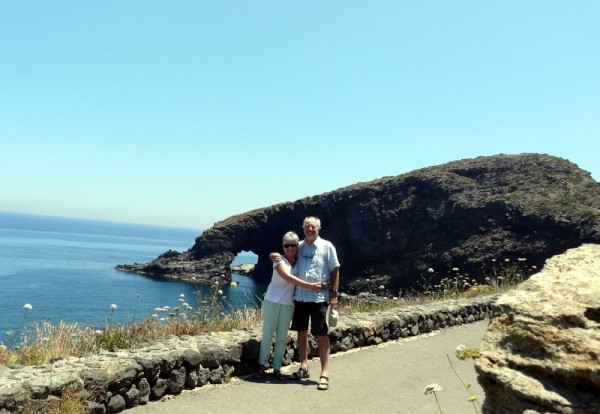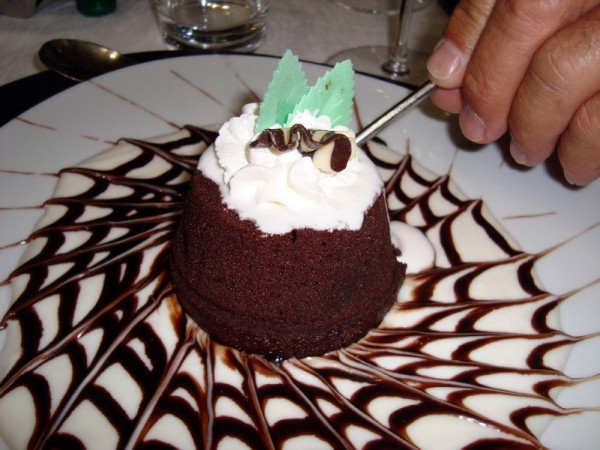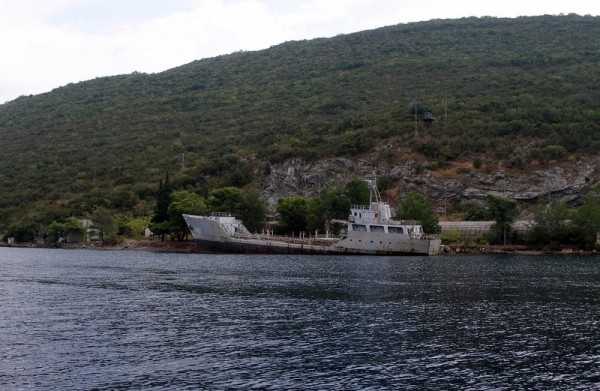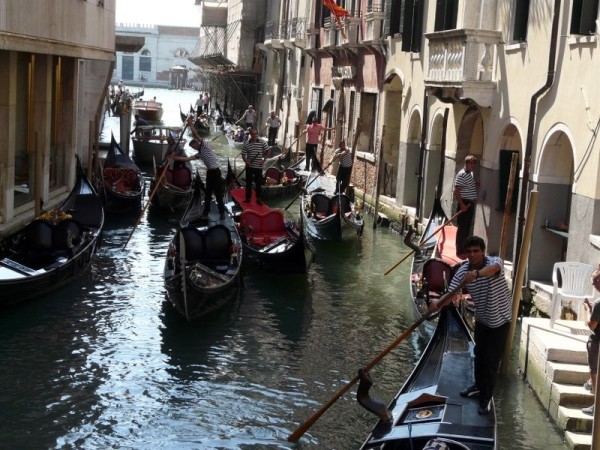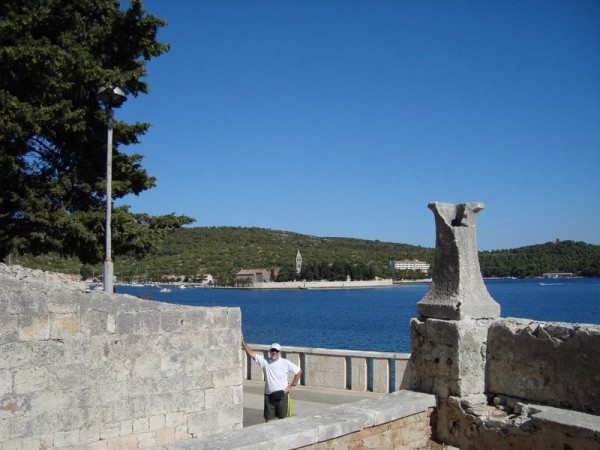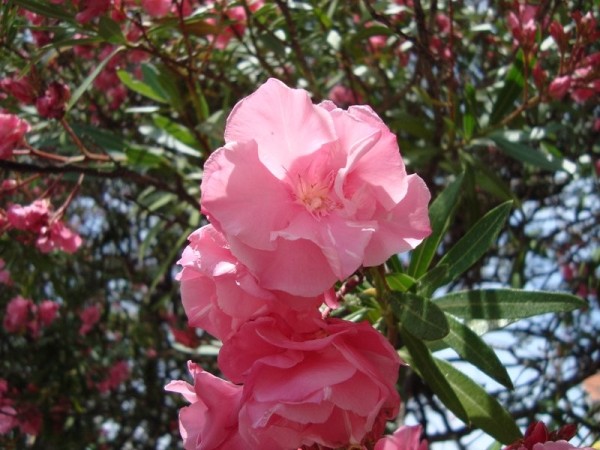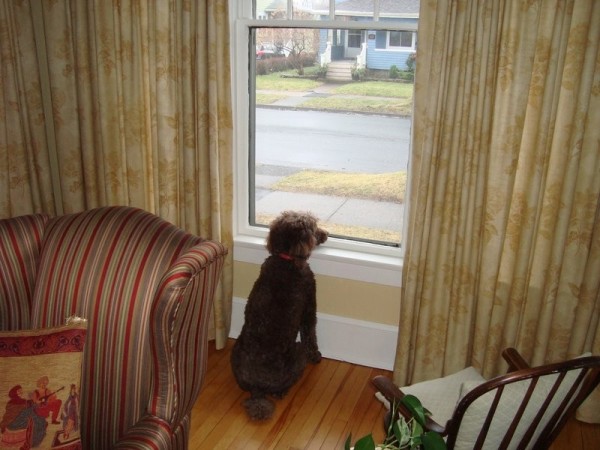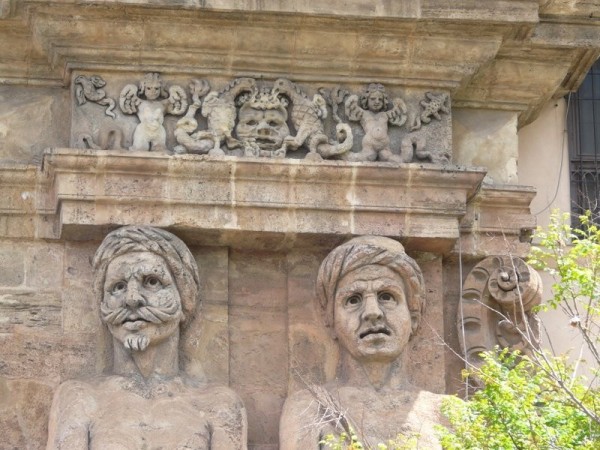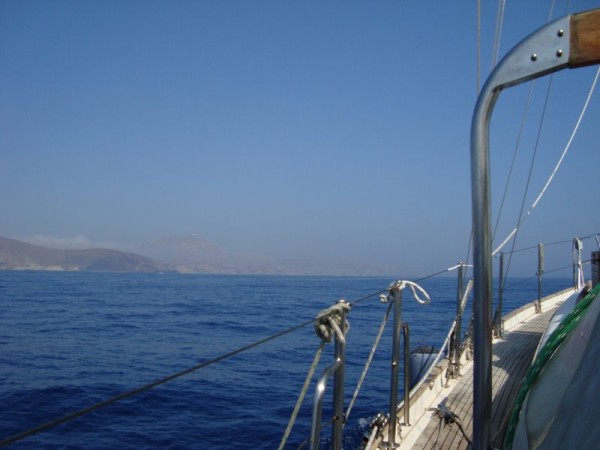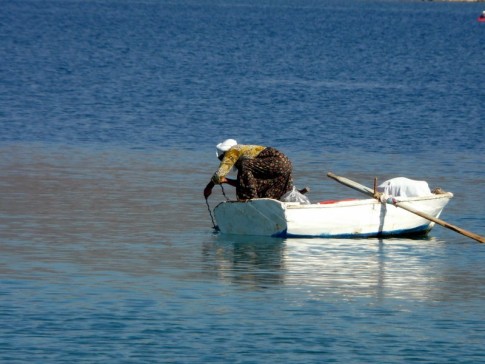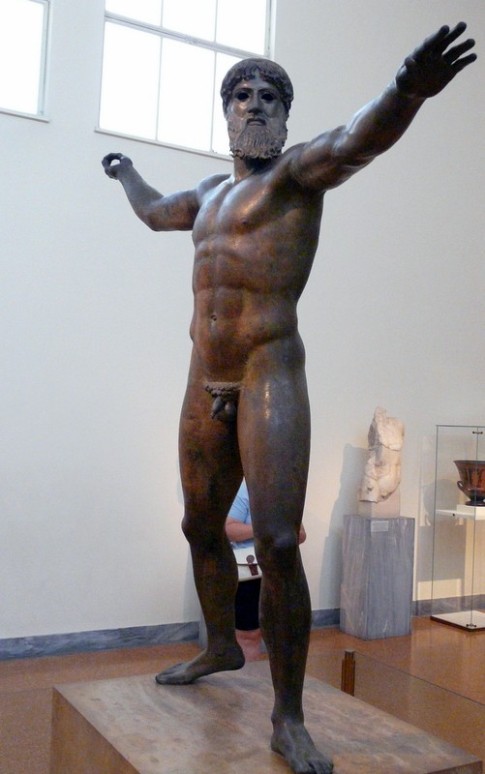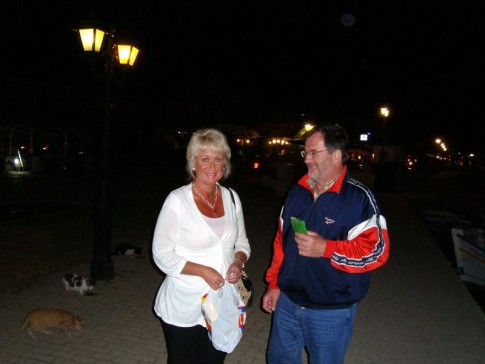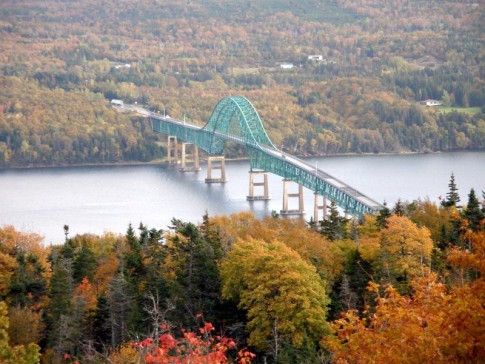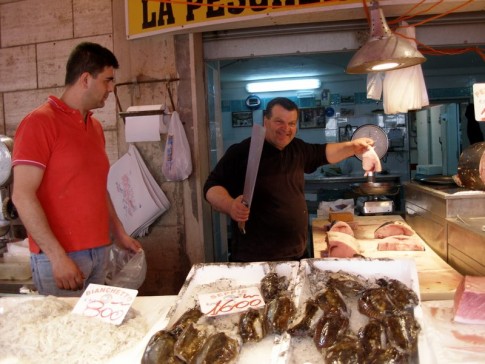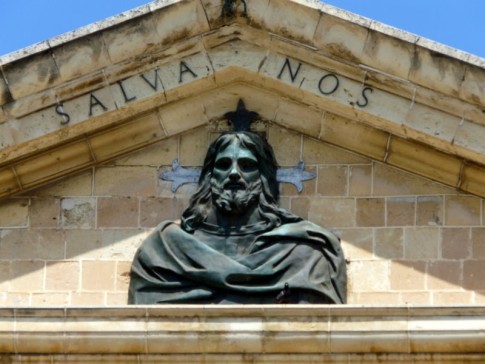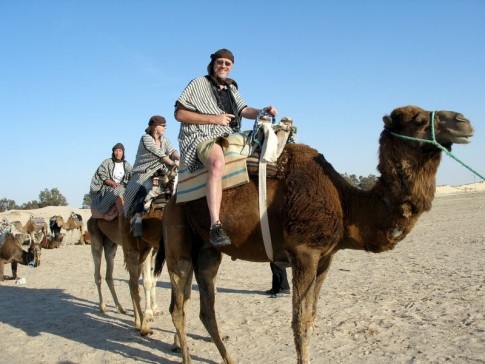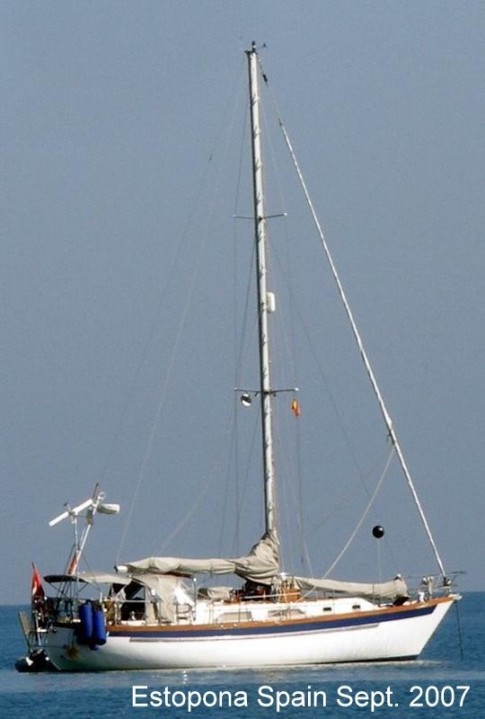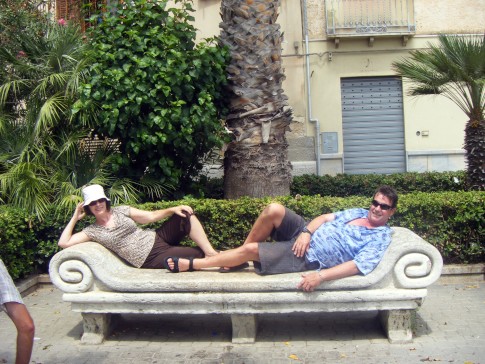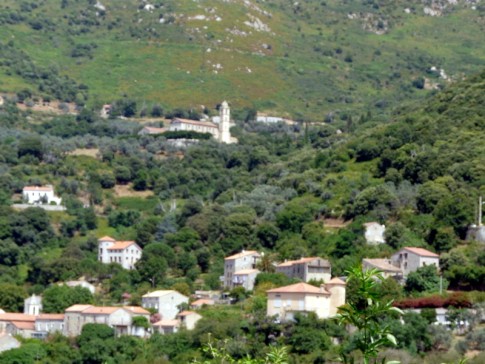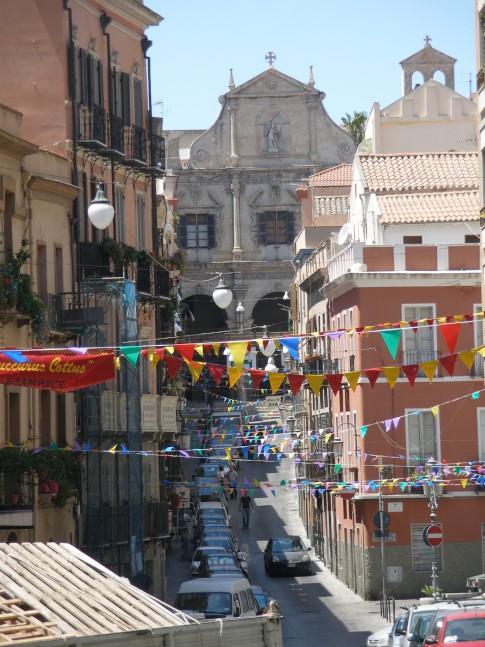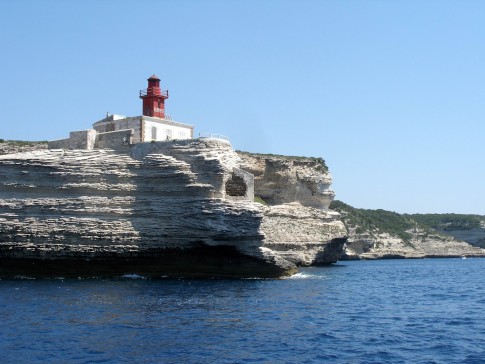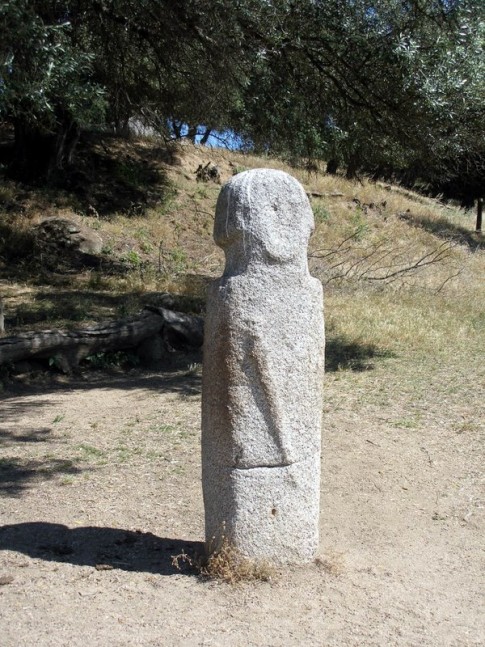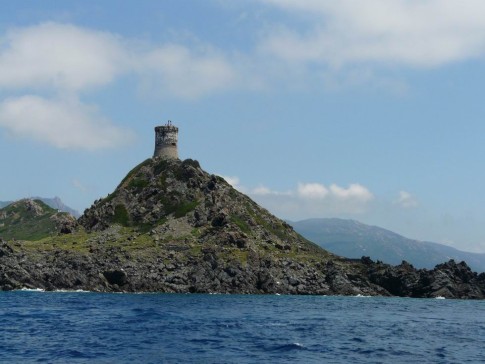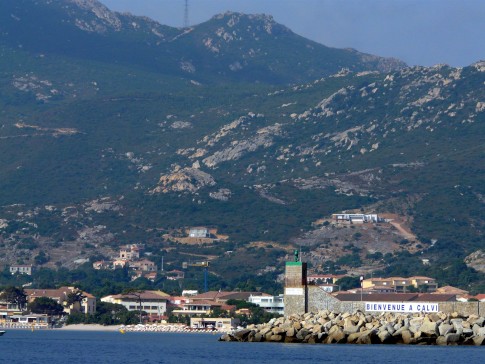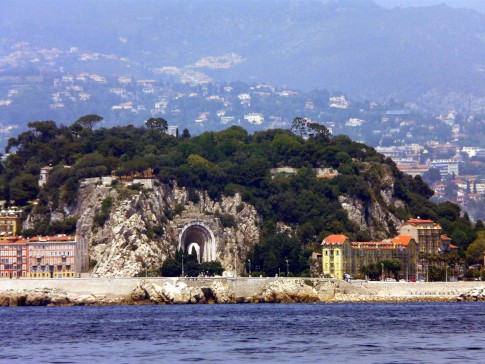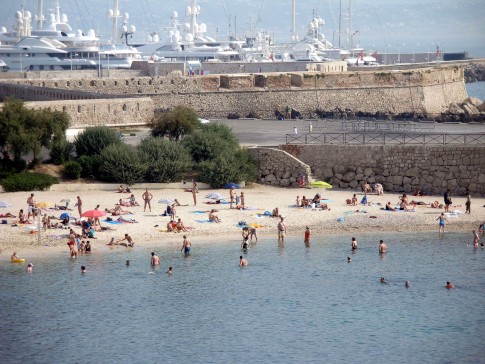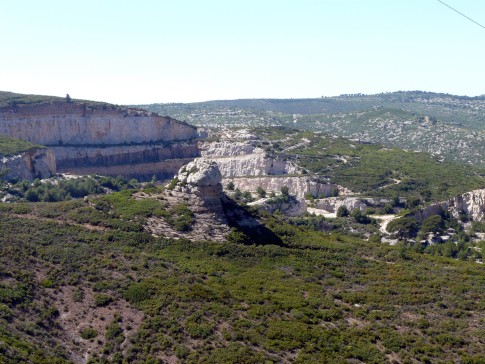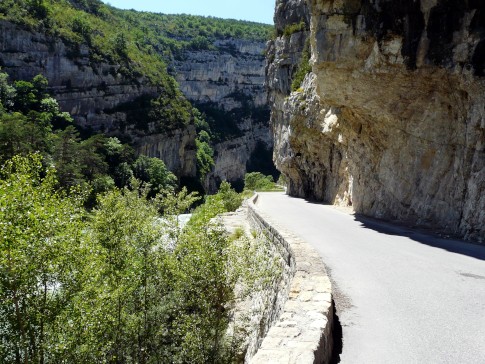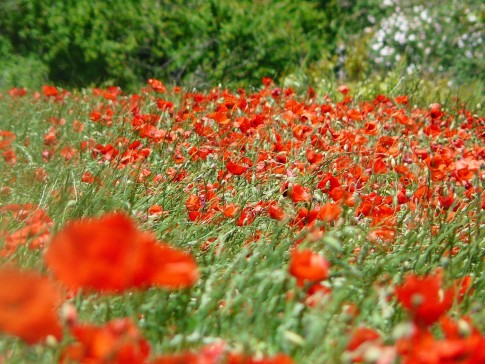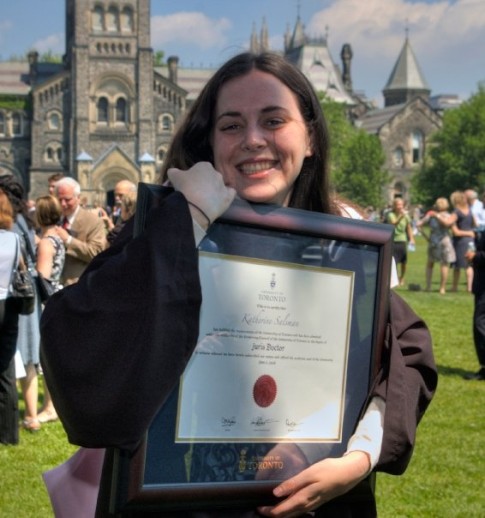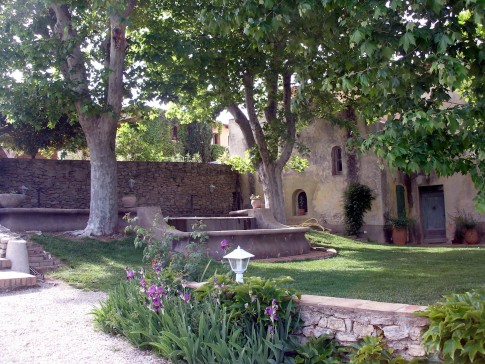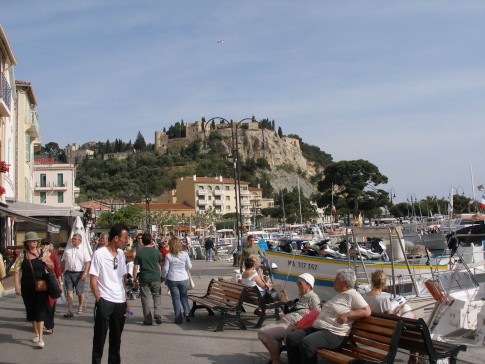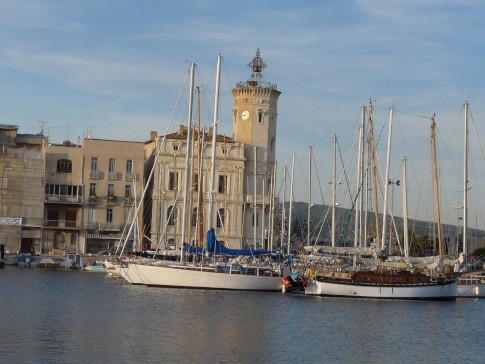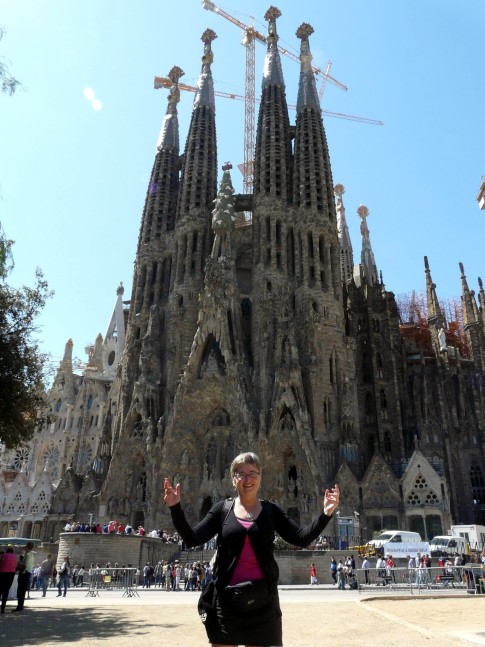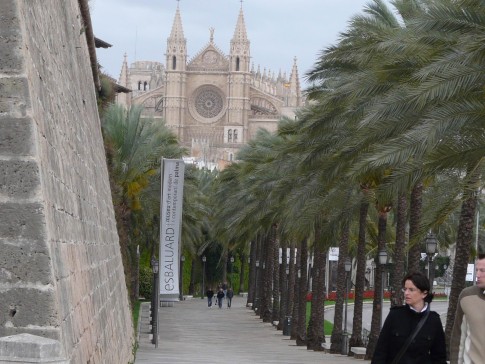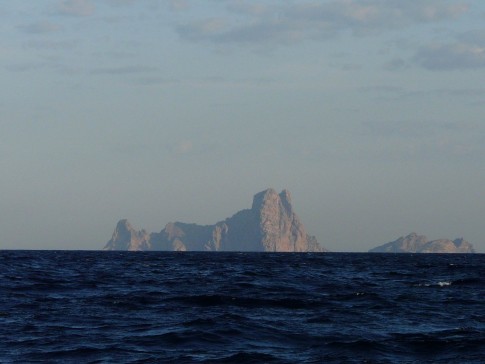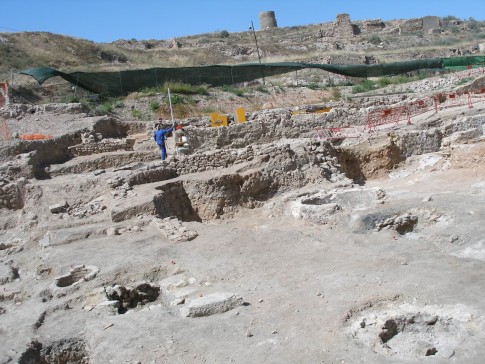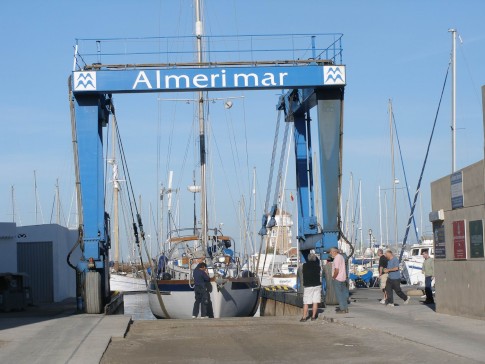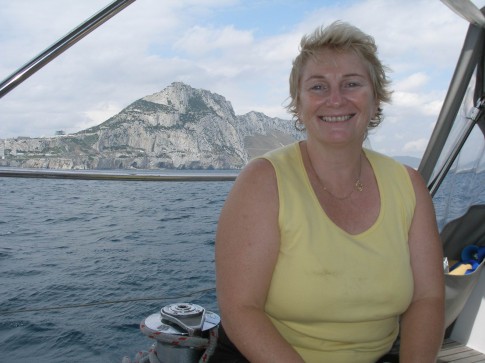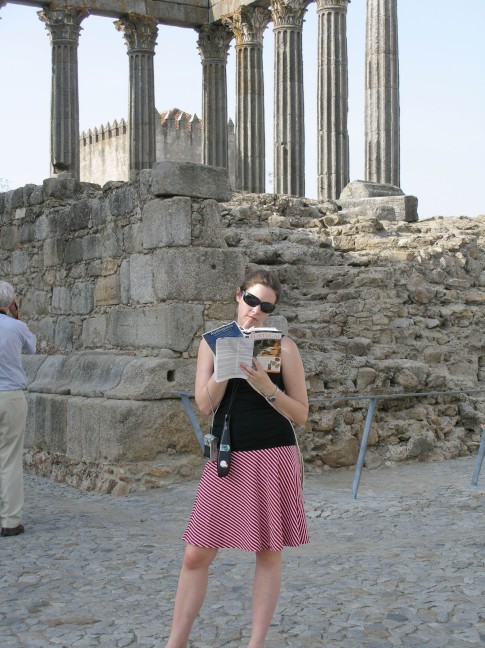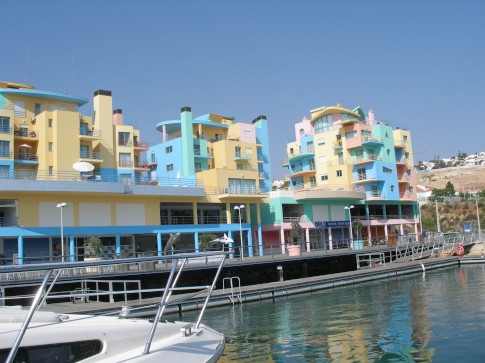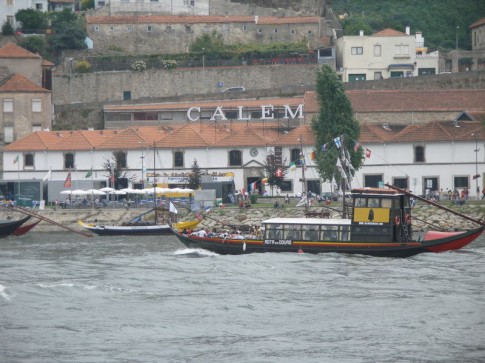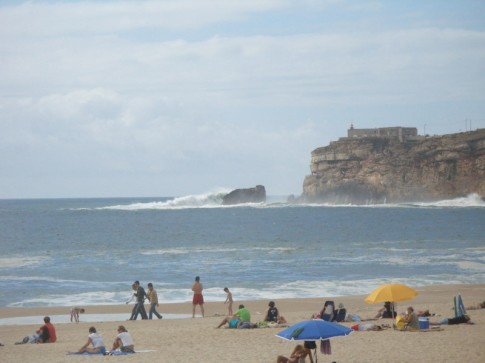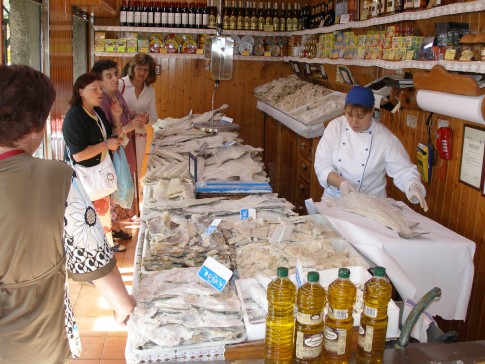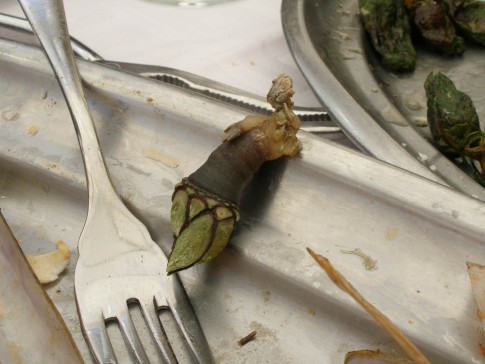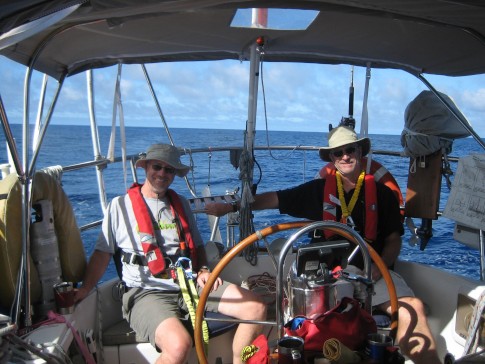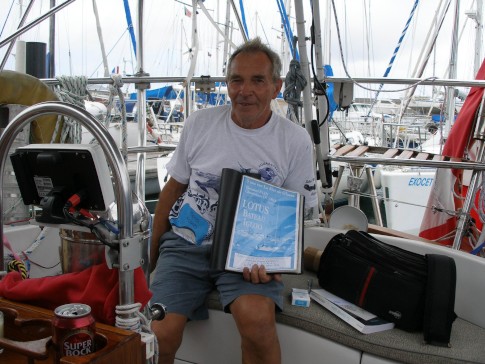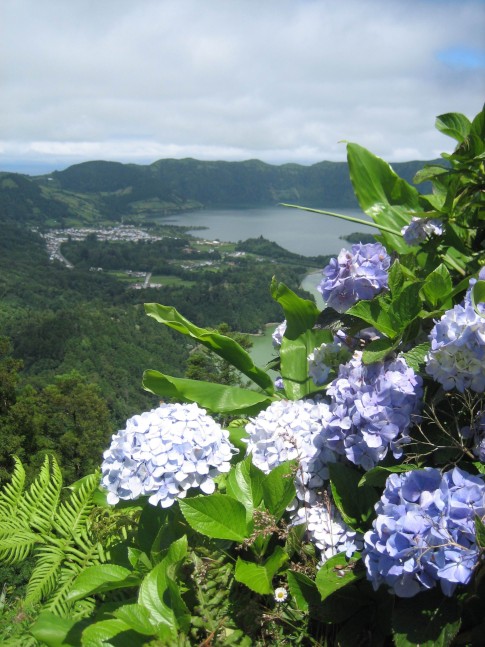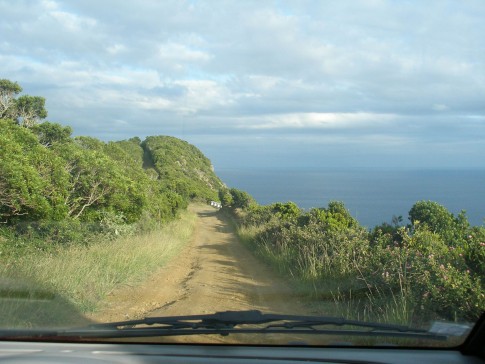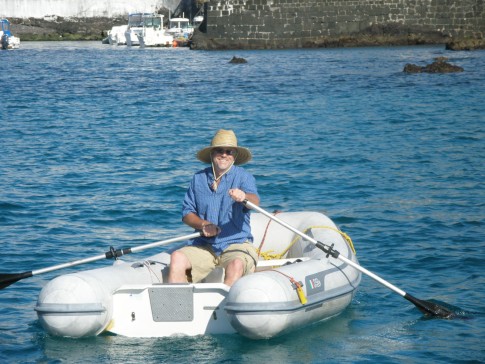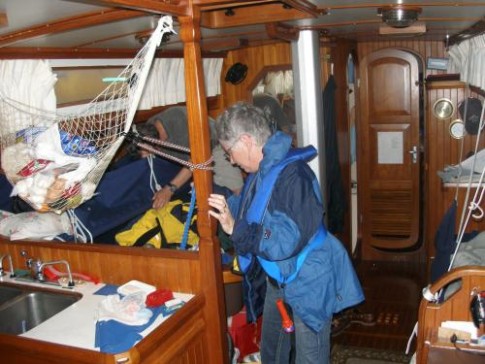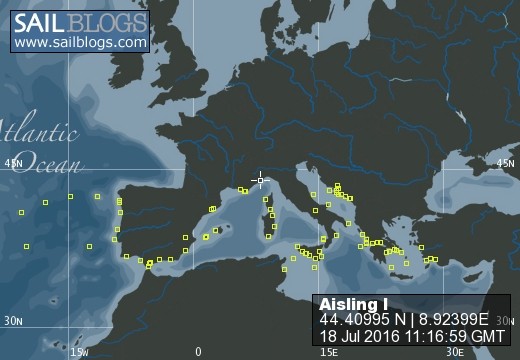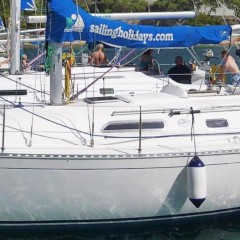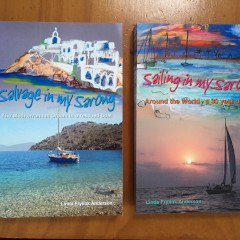
Aisling I
18 July 2016 | Genoa
11 July 2016 | Genoa Italy
04 July 2016 | Genoa
02 July 2016 | Genoa
25 June 2016 | Porto Azzurro Elba
11 April 2016 | Marina di Ragusa
21 March 2016 | Halifax
01 March 2016
14 January 2016
30 September 2015
25 September 2015 | Crotone Italy
18 September 2015 | Erikoussa
10 September 2015 | Preveza
10 September 2015 | Preveza
24 July 2015 | Preveza
20 July 2015 | Varko Bay
13 July 2015 | Vlicho Bay
09 July 2015
03 July 2015 | Preveza Greece
21 June 2015
The return to Kilada
25 August 2011
Bonnie/Hot and Sunny!
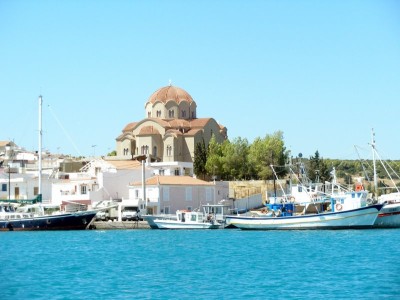
The time we spent in Nova Scotia went by in a flash, with a hugely successful 80th birthday party for my Mom at the centre point. I had worried that Rick might feel at loose ends while we were at home, since the reality of his "retirement" (a word he now occasionally says out loud) hadn't really hit home while we were sailing. Instead, he seemed visibly, expansively happy...humming to himself as he made the coffee each morning, tackling a few odd jobs around the house, planning the next phase of our summer sailing and spending some time with his parents each day. Unfortunately, his mother had a bad fall shortly after we arrived home. Although she was recovering well by the day of our departure, it was hard to say goodbye. Practically speaking, we were ready to leave; mentally, not at all.
Our spirits quickly lifted when we arrived to Kilada's bright sunshine and azure waters on Thursday afternoon. After a multi-stop flight and a three-hour drive from Athens, the bed in the tiny apartment we'd rented from "Madame Zizi" in the village looked pretty tempting, but we knew that taking a nap would only prolong our jet lag. As we sat looking out at the view of the Franchthi caves from our favourite waterfront cafe and watching the sun drop in a fiery ball at the mouth of the harbor, any worries about our lives in Halifax quickly retreated into the distance.
There had been some tiny changes in Kilada since we'd left. Although the same elderly man sat sipping his coffee at the corner table of the café, the kittens scampering underneath the trees at "10 Euro Douglas's" restaurant had become gangly adolescents and the olives on the trees had almost doubled in size. The oleanders were past their prime, with only a few straggling pink blooms remaining. The blade that had been missing from one of the propellers at the wind farm on the mountaintop across the water had been replaced, and we wondered how on earth they had managed to carry the huge blade up the treacherously narrow roads to the summit.
At Douglas's restaurant, the food seemed just a little less delicious than we'd remembered. Perhaps we'd blown it up too much in our minds, or perhaps it was because we had arrived back during the peak holiday week in Greece. Assumption Day (August 15th) has a slightly different theological interpretation in the Orthodox Church, but this day, which marks the passing of the Virgin Mary into the after-life, is celebrated just as enthusiastically here as it is in Italy. Many businesses in Greece shut down entirely during the last two weeks of August. The waiter at Douglas's seemed to be wishing he was on holiday too, because he took our order even more slowly than his usual snail's pace.
After consuming a large array of Douglas's small plates, we were rewarded with the site of a huge meteorite streaking through the sky overhead. It would have been the perfect end to a perfect night if I had not managed to tip my large Director's-style chair over backwards when the legs stuck in the grass as I pushed it back from the table. Once my feet left the ground, I was powerless to stop the momentum. My elbow hit the ground with a resounding thwack and I lay there with my legs in the air, as helpless as one of the loggerhead turtles that swim in Kilada bay. Could there be a more humiliating experience? Over the next few days, my elbow displayed a gruesome and ever-changing array of purple and red hues. The bruises to my pride were less visible, but more painful.
The next morning, we woke early and headed down the road to Lapisa to have breakfast in the restaurant of the "Lapisa Sunrise" hotel. It was a lovely spot and clearly a step up from Madame Zizi's (but we'd stayed there, we would have been 2 km from the boatyard and the price for an apartment would have been double the 40 euros a night we were paying Madame).
After breakfast, we dropped in to see Evangelos in the boatyard office, who advised us to head immediately for Nafplio (a one-hour drive away) to reclaim our cruising permit from the Customs office. In yet another example of the irritatingly officious Greek bureaucracy, we had had to surrender our cruising permit to the Kilada Port Police when the boat was hauled. The Port Police had in turn submitted it to the Customs Office. The Customs office would close at 2 p.m. that afternoon (Friday) and would not open again until Monday morning. "You'd better go now" Evangelos said, "they sometimes close early on Fridays. And before we can launch you, you also need to go back to the Port Police and buy a launching permit." By 2 p.m., we were back at the boatyard with all our paperwork in order.
Back onboard Aisling, we scampered quickly to hose the layers of dust off the decks, replace the speedometer impellor (almost forgot!) and tie on fenders and lines, By 4 p.m. Aisling was floating, even though everything was still in complete disarray below decks. Taking ten deep breaths and trying to ignore the sweat that was trickling down my back, I focused on sorting out our cabin and making up our berth. Meanwhile, since our mechanic Dimitris was on vacation in Crete, Rick checked out the new shaft seal with Dimitris' father, George. Although the new packing box looked great, the motor seemed to have a new vibration at low rpms. "It's not a problem" George insisted, "but you should check the damper plate next time you get hauled". As you might be guessing, there would be another chapter to that story.
That night, we drove back to Lapisa to have dinner at the "tharotaverna" (fish restaurant) on the beach. The waitress at the café had told us (with guilty-looking backward glances over her shoulder) that this was the best place in the area for seafood. Although it didn't seem to be noticeably better than the tharotaverna on the Kilada waterfront, it was an entertaining place to eat, with the patrons calling back and forth to each other among the tables and families arriving on the beach to fish from lawnchairs in the darkness.
We stayed at the Basimicoupolis dock until the next morning. After George had come aboard and completed a final check of the shaft alignment, we headed out to anchor in the bay. Getting away from the dock was easier said than done, with the wind gusting up over 30 knots in the puffs. The boatyard manager Lefteris mimed that we should wait for the lull between gusts before pulling away, looking like a cartoon sketch of the West Wind as he pursed his lips and puffed out his cheeks. "Now! Now! Now! Go fast! Fast!" he shouted, and we charged out at high speed, clearing a powerboat that was tied to starboard of us with only inches to spare. Within minutes, we had our anchor securely set in the mud near the fishing dock.
With a rental car at our disposal for two more days, we had thought we'd have a chance to do a little more sightseeing, but in the end our only excursions were to the Lidl store to buy groceries, to Porto Heli in search of water and to Ermione to return the car. Unfortunately, the grocery shopping wasn't as fruitful as it might have been, due to the fact that our freezer has mysteriously stopped working (which in turn means that we cannot get the fridge to cool down properly without running it for hours on end). We improvised by filling the freezer side with frozen water bottles from the supermarket and all was well, at least temporarily. Saturday night, we had our first meal aboard and watched the comings and goings from the compound on the private island in the bay, which reportedly is owned by the family that operates the "Flying Dolphin" inter-island hydrofoil ferries. Clearly a party was happening, with enough lights ablaze to illuminate a small town and guests being ferried back and forth from the Kilada dock in a constant parade. Late that night, we were treated to a sparkling display of fireworks that appeared magically from the direction of Lapisa.
After two days at anchor, Rick was ready to move on, but I begged for one more day in Kilada. I wanted to have just one more run along the dirt road that runs from the large church in the town to the tiny chapel on the point (a run that, if it were just a tiny bit longer, would be a contender for a Runner's World "Rave Run" designation). When we began our run at 0930, the day was already hot. Two elderly men sitting on a bench in the shade cheered us on in Greek, waving their fists, laughing and looking for all the world like the Statler and Waldorf characters from the Muppett Show. By the time we finished our run, a river of sweat was pouring off me. I waited outside our supermarket of choice, (where the owners by now know us as "the Canadians") while Rick went inside to buy water and ice. When he came back outside, he passed me a fistful of paper towels. "They said I should give you these", he said, "I think they find the idea of a woman running a bit strange". More likely they thought the idea of anyone running in this heat to be a bit strange!
The next morning, we finally motored out of the bay, snapping a few last-minute photos of the church and the island. I felt sad to be leaving, knowing that it was unlikely we would be back. Little did I know we would be back before sunset!
We had chosen Porto Heli as our first stop, since that seemed to offer the best possibility of finding someone to repair the fridge. Unfortunately, on the way to Porto Heli, Rick concluded that the maxprop has been set at the wrong pitch. (This probably also explained the new rattle at idle.) After phone calls to Dimitris in Crete, Bill LeBlanc in Halifax (who during the past four years has kindly provided long-distance advice on several occasions) and Evangelos in the yard, we decided we needed to return to Kilada and haul the boat to re-set the prop. The deal was that, if Rick was correct and the pitch had been set incorrectly, the haul-out would be free. If not...we would have to pay (520 Euros). "Are you sure?" I asked Rick nervously? "I'm sure", he said firmly. So back we went, arriving on time to watch one more Kilada sunset.
Our spirits quickly lifted when we arrived to Kilada's bright sunshine and azure waters on Thursday afternoon. After a multi-stop flight and a three-hour drive from Athens, the bed in the tiny apartment we'd rented from "Madame Zizi" in the village looked pretty tempting, but we knew that taking a nap would only prolong our jet lag. As we sat looking out at the view of the Franchthi caves from our favourite waterfront cafe and watching the sun drop in a fiery ball at the mouth of the harbor, any worries about our lives in Halifax quickly retreated into the distance.
There had been some tiny changes in Kilada since we'd left. Although the same elderly man sat sipping his coffee at the corner table of the café, the kittens scampering underneath the trees at "10 Euro Douglas's" restaurant had become gangly adolescents and the olives on the trees had almost doubled in size. The oleanders were past their prime, with only a few straggling pink blooms remaining. The blade that had been missing from one of the propellers at the wind farm on the mountaintop across the water had been replaced, and we wondered how on earth they had managed to carry the huge blade up the treacherously narrow roads to the summit.
At Douglas's restaurant, the food seemed just a little less delicious than we'd remembered. Perhaps we'd blown it up too much in our minds, or perhaps it was because we had arrived back during the peak holiday week in Greece. Assumption Day (August 15th) has a slightly different theological interpretation in the Orthodox Church, but this day, which marks the passing of the Virgin Mary into the after-life, is celebrated just as enthusiastically here as it is in Italy. Many businesses in Greece shut down entirely during the last two weeks of August. The waiter at Douglas's seemed to be wishing he was on holiday too, because he took our order even more slowly than his usual snail's pace.
After consuming a large array of Douglas's small plates, we were rewarded with the site of a huge meteorite streaking through the sky overhead. It would have been the perfect end to a perfect night if I had not managed to tip my large Director's-style chair over backwards when the legs stuck in the grass as I pushed it back from the table. Once my feet left the ground, I was powerless to stop the momentum. My elbow hit the ground with a resounding thwack and I lay there with my legs in the air, as helpless as one of the loggerhead turtles that swim in Kilada bay. Could there be a more humiliating experience? Over the next few days, my elbow displayed a gruesome and ever-changing array of purple and red hues. The bruises to my pride were less visible, but more painful.
The next morning, we woke early and headed down the road to Lapisa to have breakfast in the restaurant of the "Lapisa Sunrise" hotel. It was a lovely spot and clearly a step up from Madame Zizi's (but we'd stayed there, we would have been 2 km from the boatyard and the price for an apartment would have been double the 40 euros a night we were paying Madame).
After breakfast, we dropped in to see Evangelos in the boatyard office, who advised us to head immediately for Nafplio (a one-hour drive away) to reclaim our cruising permit from the Customs office. In yet another example of the irritatingly officious Greek bureaucracy, we had had to surrender our cruising permit to the Kilada Port Police when the boat was hauled. The Port Police had in turn submitted it to the Customs Office. The Customs office would close at 2 p.m. that afternoon (Friday) and would not open again until Monday morning. "You'd better go now" Evangelos said, "they sometimes close early on Fridays. And before we can launch you, you also need to go back to the Port Police and buy a launching permit." By 2 p.m., we were back at the boatyard with all our paperwork in order.
Back onboard Aisling, we scampered quickly to hose the layers of dust off the decks, replace the speedometer impellor (almost forgot!) and tie on fenders and lines, By 4 p.m. Aisling was floating, even though everything was still in complete disarray below decks. Taking ten deep breaths and trying to ignore the sweat that was trickling down my back, I focused on sorting out our cabin and making up our berth. Meanwhile, since our mechanic Dimitris was on vacation in Crete, Rick checked out the new shaft seal with Dimitris' father, George. Although the new packing box looked great, the motor seemed to have a new vibration at low rpms. "It's not a problem" George insisted, "but you should check the damper plate next time you get hauled". As you might be guessing, there would be another chapter to that story.
That night, we drove back to Lapisa to have dinner at the "tharotaverna" (fish restaurant) on the beach. The waitress at the café had told us (with guilty-looking backward glances over her shoulder) that this was the best place in the area for seafood. Although it didn't seem to be noticeably better than the tharotaverna on the Kilada waterfront, it was an entertaining place to eat, with the patrons calling back and forth to each other among the tables and families arriving on the beach to fish from lawnchairs in the darkness.
We stayed at the Basimicoupolis dock until the next morning. After George had come aboard and completed a final check of the shaft alignment, we headed out to anchor in the bay. Getting away from the dock was easier said than done, with the wind gusting up over 30 knots in the puffs. The boatyard manager Lefteris mimed that we should wait for the lull between gusts before pulling away, looking like a cartoon sketch of the West Wind as he pursed his lips and puffed out his cheeks. "Now! Now! Now! Go fast! Fast!" he shouted, and we charged out at high speed, clearing a powerboat that was tied to starboard of us with only inches to spare. Within minutes, we had our anchor securely set in the mud near the fishing dock.
With a rental car at our disposal for two more days, we had thought we'd have a chance to do a little more sightseeing, but in the end our only excursions were to the Lidl store to buy groceries, to Porto Heli in search of water and to Ermione to return the car. Unfortunately, the grocery shopping wasn't as fruitful as it might have been, due to the fact that our freezer has mysteriously stopped working (which in turn means that we cannot get the fridge to cool down properly without running it for hours on end). We improvised by filling the freezer side with frozen water bottles from the supermarket and all was well, at least temporarily. Saturday night, we had our first meal aboard and watched the comings and goings from the compound on the private island in the bay, which reportedly is owned by the family that operates the "Flying Dolphin" inter-island hydrofoil ferries. Clearly a party was happening, with enough lights ablaze to illuminate a small town and guests being ferried back and forth from the Kilada dock in a constant parade. Late that night, we were treated to a sparkling display of fireworks that appeared magically from the direction of Lapisa.
After two days at anchor, Rick was ready to move on, but I begged for one more day in Kilada. I wanted to have just one more run along the dirt road that runs from the large church in the town to the tiny chapel on the point (a run that, if it were just a tiny bit longer, would be a contender for a Runner's World "Rave Run" designation). When we began our run at 0930, the day was already hot. Two elderly men sitting on a bench in the shade cheered us on in Greek, waving their fists, laughing and looking for all the world like the Statler and Waldorf characters from the Muppett Show. By the time we finished our run, a river of sweat was pouring off me. I waited outside our supermarket of choice, (where the owners by now know us as "the Canadians") while Rick went inside to buy water and ice. When he came back outside, he passed me a fistful of paper towels. "They said I should give you these", he said, "I think they find the idea of a woman running a bit strange". More likely they thought the idea of anyone running in this heat to be a bit strange!
The next morning, we finally motored out of the bay, snapping a few last-minute photos of the church and the island. I felt sad to be leaving, knowing that it was unlikely we would be back. Little did I know we would be back before sunset!
We had chosen Porto Heli as our first stop, since that seemed to offer the best possibility of finding someone to repair the fridge. Unfortunately, on the way to Porto Heli, Rick concluded that the maxprop has been set at the wrong pitch. (This probably also explained the new rattle at idle.) After phone calls to Dimitris in Crete, Bill LeBlanc in Halifax (who during the past four years has kindly provided long-distance advice on several occasions) and Evangelos in the yard, we decided we needed to return to Kilada and haul the boat to re-set the prop. The deal was that, if Rick was correct and the pitch had been set incorrectly, the haul-out would be free. If not...we would have to pay (520 Euros). "Are you sure?" I asked Rick nervously? "I'm sure", he said firmly. So back we went, arriving on time to watch one more Kilada sunset.
Road Trip! Mycenae to Mystras
10 August 2011
Bonnie and Rick
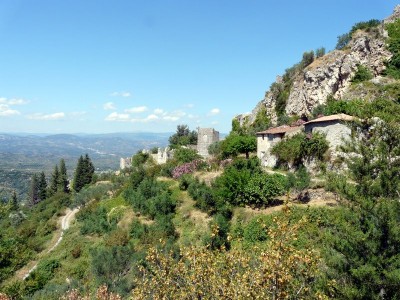
Phase two of our Peloponnesian road trip will take us further afield, so a bit of work is required to prepare Aisling for an unattended night at anchor. By 9 a.m. the hatches are closed, the garbage is emptied, the propane and pressure water are turned off and the LED anchor light is turned on. The fridge is cooled to the lowest possible temperature and pillows are stacked over the fridge doors in a futile attempt to keep the 35 degree heat out. Our milk may go sour, but at least we are confident that the anchor is solidly set with a 6:1 scope. Leaving the dinghy at the dock is one of our biggest worries. Although theft is of little concern here, the unfortunate fact is that our dingy is only insured if it is locked up. This is problematic in fishing villages like Kilada, because it is hard for us to know if we have left it a convenient spot or not. There are lots of people around, but no one to ask. The second concern is the wash from boats coming and going, which will create wear and tear on our new dinghy cover. Rick fusses with fenders and lines, snaps on the lock, and we drive away with fingers crossed.
We make a quick stop at a small bakery, where I chose a wheel of olive flatbread and a large phyllo pasty stuffed with cheese. The olive bread goes into the back seat to be saved for lunch, but we can't resist gobbling up the phyllo, which is so fresh that the cheese is warm and runny. We are still wiping grease from our faces and fingers when we arrive at Mycenae, the legendary home of Agamemnon. (Watch for my future blog post on the topic of "How to Gain Five Pounds in One Month".)
How I wish my father could be here to visit Mycenae with us! I was perhaps eight years old when he first told me the story of Helen of Troy, "the face that launched a thousand ships". Helen was the wife of Agamemnon's brother, King Menelaus of Sparta. If you've read the Iliad, and even if you haven't, you probably know that Helen's elopement with Paris of Troy started the Trojan war. Agamemnon defended his brother's honour to the end, but the story of this dysfunctional family makes the British royal family look like regular folks. Seeking wind to blow his ships to Troy, Agamemnon attempted to sacrifice his daughter Iphigenia to the gods. Even though Iphigenia was (maybe) saved at the last minute by the goddess Artemis, Agamemnon's wife Clytemnestra thought that attempting to sacrifice their daughter had been a really bad idea. In fact, she got so ticked off that she killed him. In his bathtub. Then her children Orestes and Electra got pretty upset with Clytemnestra for killing their Dad, so they killed her. And her lover Aegisthus. As you might expect, there are a lot of graves at Mycenae.
The archeological site at Mycenae actually pre-dates Agamemnon's era, and was inhabited as far back as Neolithic times. Mycenae was once the mightiest power in the Mediterranean, with an advanced culture, a trading network that ranged from Egypt to the Baltic, and a syllabic script known as "Linear B". The reasons for Mycenae's demise circa 1100 BC remain mysterious, although earthquakes and an invasion of the "Sea People" are high on the list of theories. The site at Mycenae was first excavated by a Greek team in 1841, but it was the amateur archeologist Heinrich Schliemann who made the most significant finds, discovering the shaft graves and the golden mask that he believed was the death mask of King Agamemnon. Unfortunately, Schliemann seemingly ascribed to the old adage "never let the facts get in the way of a good story", and experts have established that the mask actually dates to a period some 200 years before Agamemnon ruled. In spite of this knowledge, the mask is still commonly known as the "Mask of Agamemnon". We saw the mask when we visited the National Archeological Museum in Athens two years ago. Schliemann must have been quite taken with it, because he named his son Agamemnon.
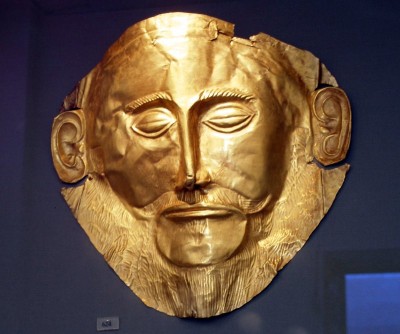
Even though the most precious treasures from Mycenae have been moved to Athens, some of the artifacts displayed in the small on-site museum are older-than-old. Looking at the everyday utensils of people who lived milennia ago always gives me an unpleasant realization of my own mortality, and I have a hard time getting my head around the dates displayed on the exhibits. The basin in this picture, for example, was already roughly 3,000 years old when Christ was born.
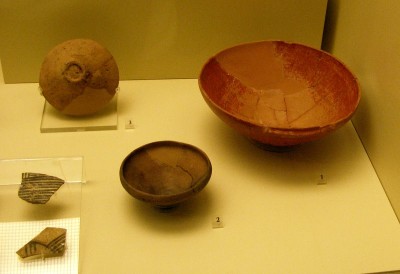
The items in this display are newer (circa 1400 BC).
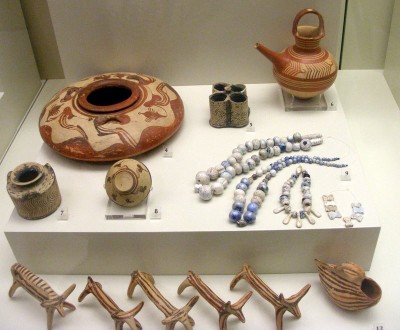
From the museum, we head up the hill to the famous "Lion Gate". Although there aren't many tourists around, a group from a small cruise ship arrives just as we do, foiling our attempts to get a perfect picture at the gate. On the other hand, their tour guide is very knowledgeable, so we hover for a while.
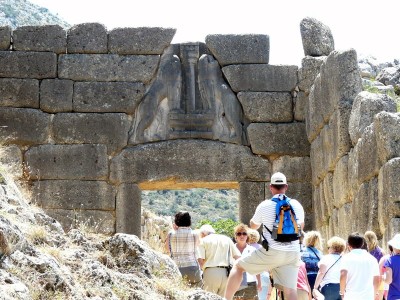
The cruise ship passengers are a young group, but they are huffing and puffing on the climb to the peak of the acropolis. One of them is literally pushed up the hill by her friends. The view from the top is the reward for the effort.
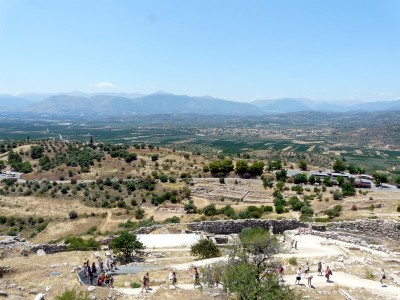
Much of the acropolis at Mycenae dates to 12th-13th centuries BC. The style of the construction is known as "Cyclopean", because the building stones were so large that the ancient Greeks thought they could only have been put in place by Cyclopes (one-eyed mythical giants). These large building stones are the single biggest evidence of their engineering skills and abilities. The wall leading to the Lions Gate is constructed of huge (8'x8' x?') stones that are fit together more tightly than you can imagine. How they managed this construction in 1200 BC boggles the mind!
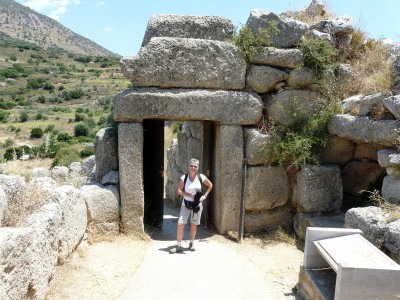
Back at the bottom, we see Grave Circle B and I suddenly realize that I have not seen Grave Circle A. Grave Circles A and B are the famous grave sites where Schliemann found some of the incredible treasures that we saw when we visited the Museum of Archeology in Athens. "You did see Grave Circle A" says Rick, "it's just past the Lion Gate". "But I didn't know what it was when I was looking at it! I have to go back" I say, and head back up the hill and through the Lion Gate again. Rick was right, I had looked at it before, but it feels different to look at it with an understanding of the significance.
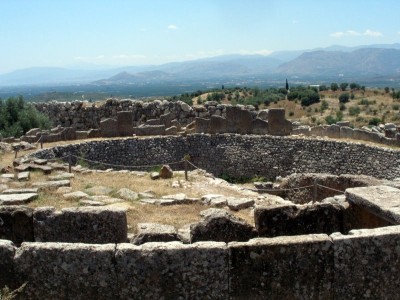
When I return, Rick has discovered one of the tholus tombs, and it's pretty amazing.
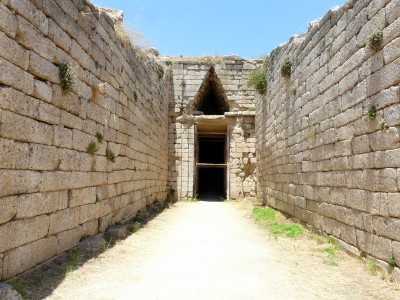
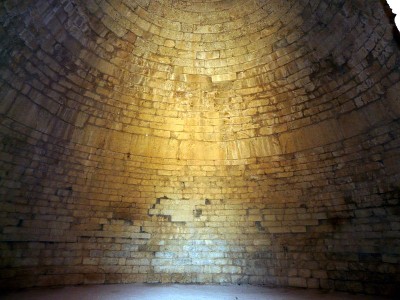
We almost bypass the "Treasury of Atreus", another tholus located outside the main site. This tomb was raided in ancient times, but is the best preserved.
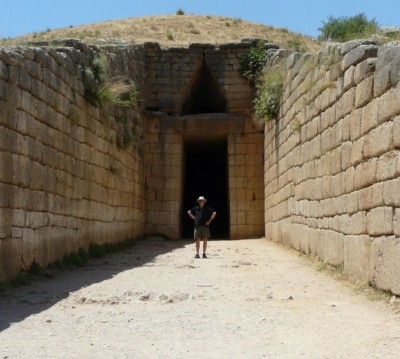
We get back on the road, unpack our lunch and head toward Sparta, passing Tripoli (Tripolitsa), which at one time was the Ottoman's administrative centre in the Peloponnese. If you need proof that war brings out the worst in mankind, consider that in 1821, in the early days of the Greek war of Independence, thousands of Turkish Muslims and Jews were massacred here by Greek forces, perhaps in retaliation for an Ottoman massacre of Greeks that had occurred months earlier. On a more pleasant historical note, Tripoli is also the hometown of our elderly Greek neighbours, Louis and Martha. But we don't drive in to the town, and instead continue on toward Sparti (Sparta). We are now in Laconia, one of the most prolific olive-growing regions in the Mediterranean. Coincidentally, the olive oil we often buy at Costco is from Laconia. Wild and cultivated olive trees are everywhere, and the majestic Taygetus mountain range is before us.
We drive through Sparta and on to Mystras, a picturesque Byzantine fortress-town. After driving up the steep hill to the upper gate of the historic site, we discover that it is has closed for the afternoon. A beautiful young French traveller, dressed in a lacey white sundress, is disconsolate. "Ce n'est pas vrai!" she wails (Frenchspeak for "Say it isn't so!"). I can't help but think that the accident of arriving on a Sunday afternoon may have saved her life, since she had apparently intended to climb the steep, rocky paths precariously balanced on cork-soled espadrilles with four inch heels. Rick, on the other hand, thinks she looked great!
Now we have no choice but to stay overnight. We drive back down the hill and investigate the rooms at the only two hotels in the village. One is available for 40 euros and the larger hotel, the Byzantion, is 50 euros. After a little bargaining, we get the Byzantion hotel (with a back garden and swimming pool) for 40 euros. We are both happy! Our pleasure at the mountain view from our balcony is surpassed only by our delight at having an air conditioner, a large bathroom and unlimited water for showers. After an hour of pool time and long, luxurious showers, we feel rejuvenated.
We stroll through the streets of the village, admiring the beautiful gardens and attractive houses. There are many orange trees, and unclaimed oranges roll in the gutters. A middle- aged couple is tending their garden and arguing vigorously as they dig potatoes. We imagine what it might be like to renovate one of the abandoned houses and settle in for a while. Maybe we could plant grapes and make wine!
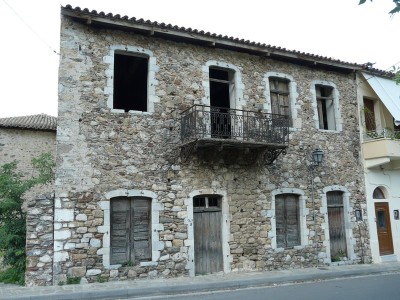
I want one of these vents for our chimney!
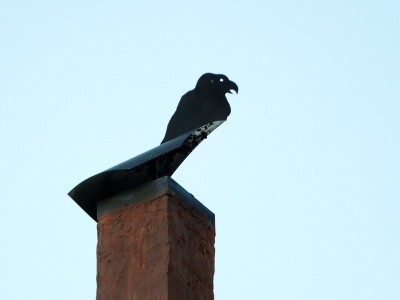
I spot a bush on the side of the road that I think might be a caper bush. "Capre?" I ask an elderly woman who is sitting in her doorway. "Neh, capari!" she nods and smiles, then offers me a few branches of fresh oregano from a bouquet and says "oregani!". We thank her, "efharisto!" and Rick snaps a photo.
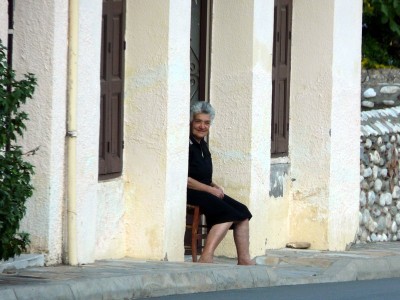
We have dinner in an open-air restaurant on the square (a delicious but greasy lamb shank with roasted potatoes for me, souvlaki for Rick) then we turn in early and sleep soundly until dawn, deliciously cool for the first night in over a month. Are road trips the best part of a sailing adventure? Maybe.
We make a quick stop at a small bakery, where I chose a wheel of olive flatbread and a large phyllo pasty stuffed with cheese. The olive bread goes into the back seat to be saved for lunch, but we can't resist gobbling up the phyllo, which is so fresh that the cheese is warm and runny. We are still wiping grease from our faces and fingers when we arrive at Mycenae, the legendary home of Agamemnon. (Watch for my future blog post on the topic of "How to Gain Five Pounds in One Month".)
How I wish my father could be here to visit Mycenae with us! I was perhaps eight years old when he first told me the story of Helen of Troy, "the face that launched a thousand ships". Helen was the wife of Agamemnon's brother, King Menelaus of Sparta. If you've read the Iliad, and even if you haven't, you probably know that Helen's elopement with Paris of Troy started the Trojan war. Agamemnon defended his brother's honour to the end, but the story of this dysfunctional family makes the British royal family look like regular folks. Seeking wind to blow his ships to Troy, Agamemnon attempted to sacrifice his daughter Iphigenia to the gods. Even though Iphigenia was (maybe) saved at the last minute by the goddess Artemis, Agamemnon's wife Clytemnestra thought that attempting to sacrifice their daughter had been a really bad idea. In fact, she got so ticked off that she killed him. In his bathtub. Then her children Orestes and Electra got pretty upset with Clytemnestra for killing their Dad, so they killed her. And her lover Aegisthus. As you might expect, there are a lot of graves at Mycenae.
The archeological site at Mycenae actually pre-dates Agamemnon's era, and was inhabited as far back as Neolithic times. Mycenae was once the mightiest power in the Mediterranean, with an advanced culture, a trading network that ranged from Egypt to the Baltic, and a syllabic script known as "Linear B". The reasons for Mycenae's demise circa 1100 BC remain mysterious, although earthquakes and an invasion of the "Sea People" are high on the list of theories. The site at Mycenae was first excavated by a Greek team in 1841, but it was the amateur archeologist Heinrich Schliemann who made the most significant finds, discovering the shaft graves and the golden mask that he believed was the death mask of King Agamemnon. Unfortunately, Schliemann seemingly ascribed to the old adage "never let the facts get in the way of a good story", and experts have established that the mask actually dates to a period some 200 years before Agamemnon ruled. In spite of this knowledge, the mask is still commonly known as the "Mask of Agamemnon". We saw the mask when we visited the National Archeological Museum in Athens two years ago. Schliemann must have been quite taken with it, because he named his son Agamemnon.

Even though the most precious treasures from Mycenae have been moved to Athens, some of the artifacts displayed in the small on-site museum are older-than-old. Looking at the everyday utensils of people who lived milennia ago always gives me an unpleasant realization of my own mortality, and I have a hard time getting my head around the dates displayed on the exhibits. The basin in this picture, for example, was already roughly 3,000 years old when Christ was born.

The items in this display are newer (circa 1400 BC).

From the museum, we head up the hill to the famous "Lion Gate". Although there aren't many tourists around, a group from a small cruise ship arrives just as we do, foiling our attempts to get a perfect picture at the gate. On the other hand, their tour guide is very knowledgeable, so we hover for a while.

The cruise ship passengers are a young group, but they are huffing and puffing on the climb to the peak of the acropolis. One of them is literally pushed up the hill by her friends. The view from the top is the reward for the effort.

Much of the acropolis at Mycenae dates to 12th-13th centuries BC. The style of the construction is known as "Cyclopean", because the building stones were so large that the ancient Greeks thought they could only have been put in place by Cyclopes (one-eyed mythical giants). These large building stones are the single biggest evidence of their engineering skills and abilities. The wall leading to the Lions Gate is constructed of huge (8'x8' x?') stones that are fit together more tightly than you can imagine. How they managed this construction in 1200 BC boggles the mind!

Back at the bottom, we see Grave Circle B and I suddenly realize that I have not seen Grave Circle A. Grave Circles A and B are the famous grave sites where Schliemann found some of the incredible treasures that we saw when we visited the Museum of Archeology in Athens. "You did see Grave Circle A" says Rick, "it's just past the Lion Gate". "But I didn't know what it was when I was looking at it! I have to go back" I say, and head back up the hill and through the Lion Gate again. Rick was right, I had looked at it before, but it feels different to look at it with an understanding of the significance.

When I return, Rick has discovered one of the tholus tombs, and it's pretty amazing.


We almost bypass the "Treasury of Atreus", another tholus located outside the main site. This tomb was raided in ancient times, but is the best preserved.

We get back on the road, unpack our lunch and head toward Sparta, passing Tripoli (Tripolitsa), which at one time was the Ottoman's administrative centre in the Peloponnese. If you need proof that war brings out the worst in mankind, consider that in 1821, in the early days of the Greek war of Independence, thousands of Turkish Muslims and Jews were massacred here by Greek forces, perhaps in retaliation for an Ottoman massacre of Greeks that had occurred months earlier. On a more pleasant historical note, Tripoli is also the hometown of our elderly Greek neighbours, Louis and Martha. But we don't drive in to the town, and instead continue on toward Sparti (Sparta). We are now in Laconia, one of the most prolific olive-growing regions in the Mediterranean. Coincidentally, the olive oil we often buy at Costco is from Laconia. Wild and cultivated olive trees are everywhere, and the majestic Taygetus mountain range is before us.
We drive through Sparta and on to Mystras, a picturesque Byzantine fortress-town. After driving up the steep hill to the upper gate of the historic site, we discover that it is has closed for the afternoon. A beautiful young French traveller, dressed in a lacey white sundress, is disconsolate. "Ce n'est pas vrai!" she wails (Frenchspeak for "Say it isn't so!"). I can't help but think that the accident of arriving on a Sunday afternoon may have saved her life, since she had apparently intended to climb the steep, rocky paths precariously balanced on cork-soled espadrilles with four inch heels. Rick, on the other hand, thinks she looked great!
Now we have no choice but to stay overnight. We drive back down the hill and investigate the rooms at the only two hotels in the village. One is available for 40 euros and the larger hotel, the Byzantion, is 50 euros. After a little bargaining, we get the Byzantion hotel (with a back garden and swimming pool) for 40 euros. We are both happy! Our pleasure at the mountain view from our balcony is surpassed only by our delight at having an air conditioner, a large bathroom and unlimited water for showers. After an hour of pool time and long, luxurious showers, we feel rejuvenated.
We stroll through the streets of the village, admiring the beautiful gardens and attractive houses. There are many orange trees, and unclaimed oranges roll in the gutters. A middle- aged couple is tending their garden and arguing vigorously as they dig potatoes. We imagine what it might be like to renovate one of the abandoned houses and settle in for a while. Maybe we could plant grapes and make wine!

I want one of these vents for our chimney!

I spot a bush on the side of the road that I think might be a caper bush. "Capre?" I ask an elderly woman who is sitting in her doorway. "Neh, capari!" she nods and smiles, then offers me a few branches of fresh oregano from a bouquet and says "oregani!". We thank her, "efharisto!" and Rick snaps a photo.

We have dinner in an open-air restaurant on the square (a delicious but greasy lamb shank with roasted potatoes for me, souvlaki for Rick) then we turn in early and sleep soundly until dawn, deliciously cool for the first night in over a month. Are road trips the best part of a sailing adventure? Maybe.
It's Not All Greek to Us! (A Road Trip to Epidaurus and Nafplio)
15 July 2011
Bonnie and Rick

I get really excited whenever I manage to decipher a word that's written in Greek. With a whole new alphabet to master, it's like learning to read all over again. Just the other day, I successfully sounded out "froo-ta" in the little fruit and vegetable shop in Kilada. Let me tell you, the guy behind the counter was pretty impressed with me. He clearly thought I had potential as a student of Greek, because he came out from behind the counter and started dashing around the shop pointing to all the fruits and saying "froo-ta", then pointing to all the vegetables and saying the Greek word for vegetable. Of course, I promptly forgot the word for vegetable but, you know, baby steps...
With just a few simple rules, you can learn the Greek alphabet too. The first surprise is that the letter you know as Beta, which you will naturally assume is pronounced like a B, is actually known as "Vita" and is pronounced like a V. There is no symbol for the B sound in Greek; instead you have to write an M and a P together, but for the P you have to use the "pi" symbol because the letter that looks like a P is actually an R. Are you still with me? The letter that looks like a V is actually an N and the letter that looks like Y is really a U (or maybe a g). Fortunately, A, K and M are the same in both alphabets. Now, here's your map, the place names are in Greek, let's test your skill on road trip! Never mind that a popular sport in the Peloponnese seems to be painting over road signs with the deliberate intention of bewildering travellers...how hard can it be?
In places, the road from Kilada to Epidaurus twists and turns like a corkscrew, with steep drop offs, few guard rails and numerous little roadside shrines marking the spots where unfortunate travellers went over the edge. Some particularly bad curves have multiple shrines. Our "Pop's Rent-a-Car" Fiat Panda maxes out at 65 km on the uphill stretches and even the big lumbering tractor trailer trucks are passing us. The altered road signs at intersections add an element of excitement. When we finally arrive at the site of the Epidaurus theatre, my hands are cramped up like claws and I realize I have been holding the sides of my seat in a death grip for most of the drive. As we park the car and head for the ticket booth, the pavement is throwing off more heat than a coke oven. "Maybe we can just get a glimpse of the theatre from the fence" Rick says hopefully, but since the acoustics of the theatre are its unique feature, we must go inside. Fortified with two bottles of cold water, we head up the path.
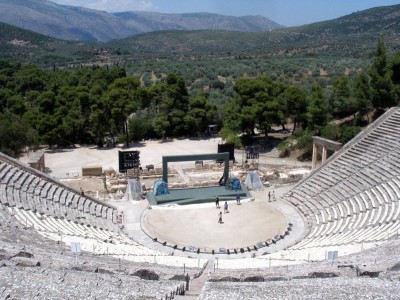
Even with the stage partly hidden by sets and props for the summer theatre festival, this huge theatre is a very special place. The theatre's seats look out over the dramatic pine-covered mountains of the Peloponnese, and the acoustics are truly amazing. From the stage and floor of the theatre, the sound comes back to you like nothing we have heard before. As an Italian woman stands on the stage and speaks to her friends, the sound reverberates so clearly that I initially think she is testing a sound system, then realize there is no microphone. I climb to the highest seat (up 112 steps, by Rick's count) and can clearly hear Rick quoting "Julius Caesar" from the stage. "I come not to praise Caesar, but to bury him" bounces off the 14,000+ seats, of which, at the moment, all but mine are empty. They say that if you drop a coin on the marble altar near the stage, the sound can be heard from the top of the theatre. That trick doesn't work for us though, maybe because of the cicadas making such a deafening racket.
We tour the small museum, where we learn much about the art of medicine in ancient times. Epidaurus was also the site of the "Asclepion", a temple dedicated to Asclepius, the god of healing. Asclepius is often portrayed holding a staff wrapped by snake, a symbol still used by the medical profession today.
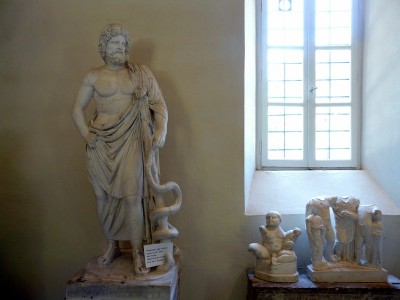
In ancient times, Epidaurus was a health care destination, and pilgrims came from far and wide to seek supernatural intervention for their ailments. And it wasn't all about praying and making offerings to Asclepius; treatments were actually given on site and some surgery was even performed.
A group of students from the American School of Classical studies in Athens are sketching statues and poring over the ancient engravings with three of their professors. As we leave the museum and walk toward the Asclepion, one professor, who really looks the part in his Indiana-Jones hat and wire-rimmed glasses, tells the students that, in keeping with the mood of the site, they should make the journey to the temple in silence...there will be opportunities for discussion later. Walking through the quiet site, with its stunning mountain views and shady pines, it is easy to imagine this as a spa destination or a place of retreat for the ancients.
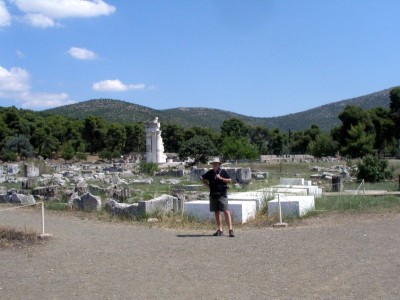
We leave the students clustered under a tree, hearing a lecture on the history of the temple. I feel quite envious, and wish we could linger to eavesdrop, but my travelling companion is very anxious to get back to the air-conditioned comfort of the car.
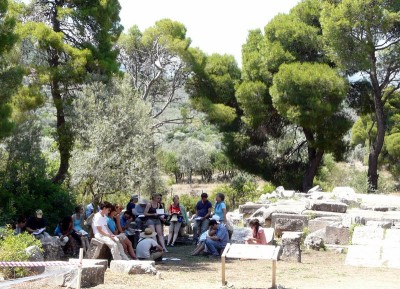
We head for Nafplio, the first capital of independent Greece, said to be one of the most beautiful cities in the country. We park on the waterfront, overlooking a small island with the Bourtzi fortress, built by the Venetians in the 15th century.
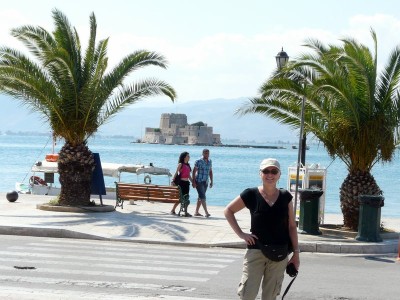
High above us looms the massive Palamidi fortress, infamous to Greeks as the place where Kolokotronis, the hero of their war of independence, was imprisoned. Our mechanic Demetrius has told us about Kolokotronis, and his imprisonment in the fortress. "If he was a hero, why was he put in prison?" asks Rick. "Because we're crazy!" says Demetrius. We decide against climbing the legendary 999 steps to the fortress. Perhaps another day.
Nafplio really is a pretty place. You've no doubt heard a bit about the demonstrations in Athen's Syntagma Square in the news; Nafplio's main square is also named "Syntagma", which means "Constitution" in Greek. There are no demonstrators here; not many people at all in fact, so we are able to get a good view of the square's marble pavement and the graceful Venetian/neo-classical style buildings that surround it. In the streets around the square, the plethora of touristy shops detracts a bit from Nafplio's charms, but, being urbanites, we love to be back in a city with cafés and people bustling about. We head for a sidewalk café for a late lunch of mixed mezza plates, then wander through a few of the shops. As we make our way back to Kilada, we drive slowly along the coast road, finding a few potential anchorages along the way. The road eventually takes us through an impressive gorge, but with no guard rails I can hardly bear to look. We are back on the boat on time to watch the sun set over the bay, marveling at the incredible pink colour of the sky. The streaks that leap from the horizon call to mind the "rosy-fingered dawns" of the Odyssey...it seems that dusk can creep out on rosy fingers too.
Soon, we will be living in a dusty boatyard, but for a few more sunsets, we are living the dream.
Traveller's note: It would be an unforgettable experience to attend a performance in the Epidaurus theatre, but this may not be the right year to try it. Our Argentinian neighbours in the boatyard booked tickets, rented a car and drove the 60+ minutes to get there, only to be told that the performers were on strike!
With just a few simple rules, you can learn the Greek alphabet too. The first surprise is that the letter you know as Beta, which you will naturally assume is pronounced like a B, is actually known as "Vita" and is pronounced like a V. There is no symbol for the B sound in Greek; instead you have to write an M and a P together, but for the P you have to use the "pi" symbol because the letter that looks like a P is actually an R. Are you still with me? The letter that looks like a V is actually an N and the letter that looks like Y is really a U (or maybe a g). Fortunately, A, K and M are the same in both alphabets. Now, here's your map, the place names are in Greek, let's test your skill on road trip! Never mind that a popular sport in the Peloponnese seems to be painting over road signs with the deliberate intention of bewildering travellers...how hard can it be?
In places, the road from Kilada to Epidaurus twists and turns like a corkscrew, with steep drop offs, few guard rails and numerous little roadside shrines marking the spots where unfortunate travellers went over the edge. Some particularly bad curves have multiple shrines. Our "Pop's Rent-a-Car" Fiat Panda maxes out at 65 km on the uphill stretches and even the big lumbering tractor trailer trucks are passing us. The altered road signs at intersections add an element of excitement. When we finally arrive at the site of the Epidaurus theatre, my hands are cramped up like claws and I realize I have been holding the sides of my seat in a death grip for most of the drive. As we park the car and head for the ticket booth, the pavement is throwing off more heat than a coke oven. "Maybe we can just get a glimpse of the theatre from the fence" Rick says hopefully, but since the acoustics of the theatre are its unique feature, we must go inside. Fortified with two bottles of cold water, we head up the path.

Even with the stage partly hidden by sets and props for the summer theatre festival, this huge theatre is a very special place. The theatre's seats look out over the dramatic pine-covered mountains of the Peloponnese, and the acoustics are truly amazing. From the stage and floor of the theatre, the sound comes back to you like nothing we have heard before. As an Italian woman stands on the stage and speaks to her friends, the sound reverberates so clearly that I initially think she is testing a sound system, then realize there is no microphone. I climb to the highest seat (up 112 steps, by Rick's count) and can clearly hear Rick quoting "Julius Caesar" from the stage. "I come not to praise Caesar, but to bury him" bounces off the 14,000+ seats, of which, at the moment, all but mine are empty. They say that if you drop a coin on the marble altar near the stage, the sound can be heard from the top of the theatre. That trick doesn't work for us though, maybe because of the cicadas making such a deafening racket.
We tour the small museum, where we learn much about the art of medicine in ancient times. Epidaurus was also the site of the "Asclepion", a temple dedicated to Asclepius, the god of healing. Asclepius is often portrayed holding a staff wrapped by snake, a symbol still used by the medical profession today.

In ancient times, Epidaurus was a health care destination, and pilgrims came from far and wide to seek supernatural intervention for their ailments. And it wasn't all about praying and making offerings to Asclepius; treatments were actually given on site and some surgery was even performed.
A group of students from the American School of Classical studies in Athens are sketching statues and poring over the ancient engravings with three of their professors. As we leave the museum and walk toward the Asclepion, one professor, who really looks the part in his Indiana-Jones hat and wire-rimmed glasses, tells the students that, in keeping with the mood of the site, they should make the journey to the temple in silence...there will be opportunities for discussion later. Walking through the quiet site, with its stunning mountain views and shady pines, it is easy to imagine this as a spa destination or a place of retreat for the ancients.

We leave the students clustered under a tree, hearing a lecture on the history of the temple. I feel quite envious, and wish we could linger to eavesdrop, but my travelling companion is very anxious to get back to the air-conditioned comfort of the car.

We head for Nafplio, the first capital of independent Greece, said to be one of the most beautiful cities in the country. We park on the waterfront, overlooking a small island with the Bourtzi fortress, built by the Venetians in the 15th century.

High above us looms the massive Palamidi fortress, infamous to Greeks as the place where Kolokotronis, the hero of their war of independence, was imprisoned. Our mechanic Demetrius has told us about Kolokotronis, and his imprisonment in the fortress. "If he was a hero, why was he put in prison?" asks Rick. "Because we're crazy!" says Demetrius. We decide against climbing the legendary 999 steps to the fortress. Perhaps another day.
Nafplio really is a pretty place. You've no doubt heard a bit about the demonstrations in Athen's Syntagma Square in the news; Nafplio's main square is also named "Syntagma", which means "Constitution" in Greek. There are no demonstrators here; not many people at all in fact, so we are able to get a good view of the square's marble pavement and the graceful Venetian/neo-classical style buildings that surround it. In the streets around the square, the plethora of touristy shops detracts a bit from Nafplio's charms, but, being urbanites, we love to be back in a city with cafés and people bustling about. We head for a sidewalk café for a late lunch of mixed mezza plates, then wander through a few of the shops. As we make our way back to Kilada, we drive slowly along the coast road, finding a few potential anchorages along the way. The road eventually takes us through an impressive gorge, but with no guard rails I can hardly bear to look. We are back on the boat on time to watch the sun set over the bay, marveling at the incredible pink colour of the sky. The streaks that leap from the horizon call to mind the "rosy-fingered dawns" of the Odyssey...it seems that dusk can creep out on rosy fingers too.
Soon, we will be living in a dusty boatyard, but for a few more sunsets, we are living the dream.
Traveller's note: It would be an unforgettable experience to attend a performance in the Epidaurus theatre, but this may not be the right year to try it. Our Argentinian neighbours in the boatyard booked tickets, rented a car and drove the 60+ minutes to get there, only to be told that the performers were on strike!
Living Hard in Kilada
10 July 2011 | Kilada, S.Pelopenesse, Greece
Rick
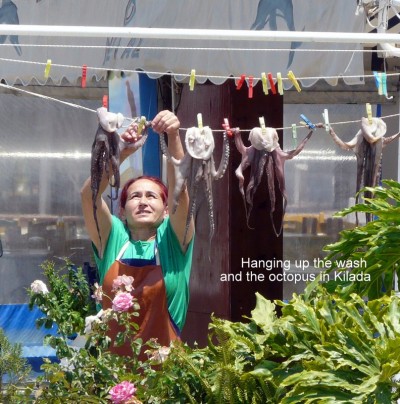
It's now been 3 days living on the hard here in Basimakopouloi Shipyard in Kilada and it feels like 3 weeks. It's not easy living 11' off the ground under a tarp to keep the 37 degree heat at bay. The yard is not paved of course and the fine dust is everywhere. Last night I neglected to use the washroom before bed and "had to go" at 3:00pm. Get out of bed, find my glasses, some clothes(it's too hot in bed with any on) climb down the ladder, worry about the vicious(?) guard dogs while I make my way to the Turkish toilet and then do everything in reverse. Yes, this is a glamorous lifestyle, isn't it?
There are pluses though, even with the "hard". Last night we finally made it out for a drink and then a bite to eat. Kilada is a small fishing village of, I'm guessing, about 1000 people. Even though this is not a tourist destination, there are about 24 restaurants and bars along the seafront. This apparent discrepancy, in Nova Scotian terms, of the ratio between inhabitants and establishments is incongruous, until you realize that eating out is a huge part of the culture here in Greece, at all income levels. This is what they do and it is fun to watch and take part in. There are families , with young kids playing hide and seek, elderly couples who need help just getting from the car to the table, skaters, "the boys" in their 20's, young girls in their 20's, dressed to the nines, a small sprinkling of tourists (mostly French for some reason), tables of business men, tables of fishermen and us. Although we do not speak Greek, it seems based on observation of tone and gesticulating that they are all instructing their table partners on the better way to do what ever. You could spend hours people-watching here.
Back to our mission. It is 9:00pm, we have decided we will first go to a bar for a drink and then find a restaurant / taverna. We are looking for an "experience". The manager at the shipyard mentioned a few restaurants to us and one of them was "10 Euro Douglas" I didn't understand his pronunciation, at first and he explained that the owner looked like Kirk Douglas and it always costs 10 euros no matter what you eat. There is no sign on this taverna but I ask and a helpful gentleman points out "Douglas" to us. Inside there are no tables just a kitchen and outside is a grill just being loaded with charcoal. The tables are across the street on the grass median. I ask for a menu and there is no menu, the owner explains in broken english, "salad, calamares, small fishes........" OK?",.... " how much?" I ask and with a shrug " look" he replies, gesturing to his kitchen, "not much... not more than 15 euros". Maybe 10 euro Douglas is now 15 euro Douglas, or maybe we dressed up too much, but this sounds like the experience we want! No one is eating yet so we decide to have a drink first.
We continue on down the street and find a "bar" with comfortable wicker chairs and some music playing. I ask the waitress what are all those brown colored drinks I see and she tells us they are iced espresso. This sounds delicious but Bon pipes in and says "Rick, it's 9:00pm, you will never get to sleep." The waitress smiles and I order a Mythos and Bon orders a glass of wine, which comes as a little mini-bottle. The setting is beautiful with all the fishing boats lined up, med moored, to the sidewalk across the street. There are about 25 sailboats at anchor in the harbour and the Franchetti Caves are just off to the left across the harbour. The people watching begins and all those I mention above are here or near. We are enjoying ourselves.
After our drinks we head back to 10 Euro Douglas's and find a table amongst all the cats. There are cats everywhere in Greece. The young man who is waiting on tables speaks no English but does ask " Bira or Vino?" and we order Vino and he responds with this tilted head shrug that clearly means "it will be my pleasure, of course". There is no other order placed, the dishes just start arriving. First it is small cooked "fishes" marinated in lemon and herbs and oil. Wow we are off to a great start. Then the rest roll in. As the waiter displays a plate, we respond yes or no...... stewed onion and eggplant in meaty sauce, fried egg plant slices served cold with tomato sauce, feta and mint and a mayonnaise fish salad on the side, mini calameraes deep fried, deep fried anchovies cleaned and de-headed served with a different tomato sauce, cooked red beets and greens in olive oil and wine vinegar. All of these are outstanding. Who says Greek cooking is not world class? This meal is one to be remembered. There is more, but by this time we are filled to the gills,as it were, and I can hardly move and am dreaming of my bed. We ask for the bill and after much contemplation while holding his pen on the pad he finally says 30 euros, without writing anything. Well, its not the 10 we were led to expect, but for 15 euros each this a "do again" as Bonnie and I usually say. On the other hand, we have 23 other places to try!
There are pluses though, even with the "hard". Last night we finally made it out for a drink and then a bite to eat. Kilada is a small fishing village of, I'm guessing, about 1000 people. Even though this is not a tourist destination, there are about 24 restaurants and bars along the seafront. This apparent discrepancy, in Nova Scotian terms, of the ratio between inhabitants and establishments is incongruous, until you realize that eating out is a huge part of the culture here in Greece, at all income levels. This is what they do and it is fun to watch and take part in. There are families , with young kids playing hide and seek, elderly couples who need help just getting from the car to the table, skaters, "the boys" in their 20's, young girls in their 20's, dressed to the nines, a small sprinkling of tourists (mostly French for some reason), tables of business men, tables of fishermen and us. Although we do not speak Greek, it seems based on observation of tone and gesticulating that they are all instructing their table partners on the better way to do what ever. You could spend hours people-watching here.
Back to our mission. It is 9:00pm, we have decided we will first go to a bar for a drink and then find a restaurant / taverna. We are looking for an "experience". The manager at the shipyard mentioned a few restaurants to us and one of them was "10 Euro Douglas" I didn't understand his pronunciation, at first and he explained that the owner looked like Kirk Douglas and it always costs 10 euros no matter what you eat. There is no sign on this taverna but I ask and a helpful gentleman points out "Douglas" to us. Inside there are no tables just a kitchen and outside is a grill just being loaded with charcoal. The tables are across the street on the grass median. I ask for a menu and there is no menu, the owner explains in broken english, "salad, calamares, small fishes........" OK?",.... " how much?" I ask and with a shrug " look" he replies, gesturing to his kitchen, "not much... not more than 15 euros". Maybe 10 euro Douglas is now 15 euro Douglas, or maybe we dressed up too much, but this sounds like the experience we want! No one is eating yet so we decide to have a drink first.
We continue on down the street and find a "bar" with comfortable wicker chairs and some music playing. I ask the waitress what are all those brown colored drinks I see and she tells us they are iced espresso. This sounds delicious but Bon pipes in and says "Rick, it's 9:00pm, you will never get to sleep." The waitress smiles and I order a Mythos and Bon orders a glass of wine, which comes as a little mini-bottle. The setting is beautiful with all the fishing boats lined up, med moored, to the sidewalk across the street. There are about 25 sailboats at anchor in the harbour and the Franchetti Caves are just off to the left across the harbour. The people watching begins and all those I mention above are here or near. We are enjoying ourselves.
After our drinks we head back to 10 Euro Douglas's and find a table amongst all the cats. There are cats everywhere in Greece. The young man who is waiting on tables speaks no English but does ask " Bira or Vino?" and we order Vino and he responds with this tilted head shrug that clearly means "it will be my pleasure, of course". There is no other order placed, the dishes just start arriving. First it is small cooked "fishes" marinated in lemon and herbs and oil. Wow we are off to a great start. Then the rest roll in. As the waiter displays a plate, we respond yes or no...... stewed onion and eggplant in meaty sauce, fried egg plant slices served cold with tomato sauce, feta and mint and a mayonnaise fish salad on the side, mini calameraes deep fried, deep fried anchovies cleaned and de-headed served with a different tomato sauce, cooked red beets and greens in olive oil and wine vinegar. All of these are outstanding. Who says Greek cooking is not world class? This meal is one to be remembered. There is more, but by this time we are filled to the gills,as it were, and I can hardly move and am dreaming of my bed. We ask for the bill and after much contemplation while holding his pen on the pad he finally says 30 euros, without writing anything. Well, its not the 10 we were led to expect, but for 15 euros each this a "do again" as Bonnie and I usually say. On the other hand, we have 23 other places to try!
| Vessel Name: | Aisling I |
| Vessel Make/Model: | Slocum 43 |
| Hailing Port: | Halifax, NS, Canada |
| Crew: | Rick and Bonnie Salsman |
| About: | |
| Extra: | |
| Social: |
Aisling I's Photos - Aisling I (Main)
About Aisling 1
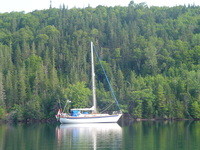
Who: Rick and Bonnie Salsman
Port: Halifax, NS, Canada
Quick Links
- Miscellaneous
- Greece-other
- Croatia and Montenegro 2012
- Sicily 2011-2014
- Italy (Mainland) 2012
- Weather and Technical
- Turkey
- Greece-Aegean
- Syracuse 2009
- Tunisia
- Malta
- Greece Ionian & Gulf of Corinth
- Sicily 2008
- Corsica and Sardinia
- Southern France
- Transatlantic part 2-Azores to Baiona
- Azores 2007
- South Spain & Balearics-2008
- South Spain & Gibraltar 2007
- Portugal 2007
- Atlantic Spain
- Transatlantic part 1-Halifax to Azores
- Previous Trips
- pre departure
- Show All Posts








